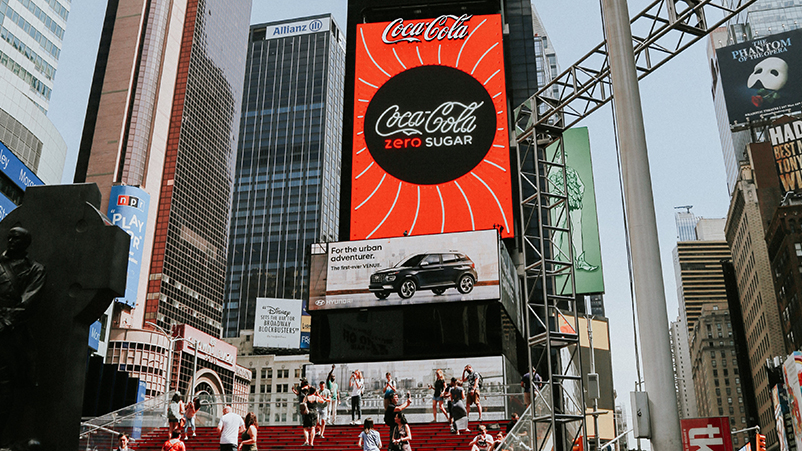WARC benchmarks ad investment by product category

TV still attracts over two-thirds of advertising investment within the soft drinks sector, while a similar share is seen in the food category, according to WARC’s relaunched data product, which benchmarks ad investment by product category.
According to its latest report, both of those sectors are far less likely to have been disrupted by e-commerce, so the need for high levels of digital adspend to facilitate a path to purchase is reduced.
However, the pivot to online advertising is particularly stark within financial services and retail, with both sectors having heavily developed digital platforms to serve their customers in recent years.
WARC's Data product provides a new industry-standard measure of net advertising investment data across 19 product categories in 23 markets, including the United States, United Kingdom and China.
Key findings for five of the 19 product categories available include:
Financial Services
- Total global adspend in 2018: $43.2bn (+13.0% year-on-year)
- Median revenue ROI for successful campaigns: 2.93
- Media spend: Internet $19.7bn (+24.4% year-on-year). TV $12.9bn (+4.0%). Radio $3.7bn (+5.1%). Other $7.0bn (+6.7%)
- Ad/sales ratios: Financial services (3.6%). Banks, credit, loans (6.7%). Insurance (0.8%). Investment (1.5%).
Close to half of the $43.2bn financial services brands invested in advertising last year was directed towards internet formats. The data show a dramatic shift to digital over the last five years; internet’s share of sector spend has grown 22.0 percentage points (pp) since 2013, to 45.5% last year. This is just above internet’s share of global adspend (44.1%). As a share of sales revenue, the sector spends 3.6% on advertising, rising to 6.7% among banks.
Food
- Total global adspend in 2018: $25.3bn (+1.4% year-on-year)
- Median revenue ROI for successful campaigns: 2.93
- Media spend: TV $16.5bn (+1.0% year-on-year). Internet $3.7bn (+7.9%). Print $2.8bn (-12.7%). Other $2.3bn (+15.3%)
- Ad/sales ratios: Food (2.6%). Confectionery (5.6%). Dairy (0.6%). Meat, fish, poultry (0.7%).
Almost two-thirds of the $25.3bn in ad investment within the food category last year was spent on TV, nearly double TV’s global share of 33.3%. TV spend in the sector rose 1.0% year-on-year to $16.5bn in 2018 but has dipped by 3.7% each year since 2013 on a compound basis. Print also accounts for a greater share of food adspend than is the case globally, with newspapers’ (-2.6pp) and magazines’ (-2.1pp) share dipping mildly over the last five years.
Retail
- Total global adspend in 2018: $62.3bn (+0.0% year-on-year)
- Median revenue ROI for successful campaigns: 4.40
- Media spend: Internet $21.5bn (+9.1% year-on-year). TV $20.3bn (-0.6%). Print $9.6bn (-15.5%). Other $10.9bn (+0.8%)
- Ad/sales ratios: Retail 2.3%. Clothing & fashion (2.9%). Restaurants (2.0%). Supermarkets (1.2%).
Global advertising spend in the retail sector was flat in 2018 at $62.3bn. The $1.8bn in extra internet spend (up 9.1% from 2017) was offset by a decline in spend for all other media bar out of home (+12.7%) and cinema (+4.9%). Ad investment among the retail sector has tracked downwards in recent years, recording a compound annual growth rate of -1.8% since 2013. However, online advertising has become far more valuable to the sector during this time.
Soft drinks
- Total global adspend in 2018: $15.1bn (+1.1% year-on-year)
- Median revenue ROI for successful campaigns: 2.84
- Media spend: TV $10.5bn (+1.1% year-on-year). Internet $1.9bn (+28.3%). OOH $1.3bn (-24.1%). Other $1.4bn (+1.3%)
- Ad/sales ratios: Soft drinks (5.9%). Bottled water (5.9%). Carbonated (5.9%).
At 70.0%, TV’s share of soft drinks brands’ adspend is higher than all other categories studied for the report. The $10.5bn spent on TV ads in 2018 was up 1.1% from 2017 and has grown at a compound rate of 2.0% each year since 2013 – bucking the global trend. However, investment in other media – chiefly internet – has eroded TV’s share of sector spend by 4.4pp over the five years to 2018. Internet formats still draw a relatively small amount of investment, at 12.8%; this is almost three times less than the global level and is likely a reflection of how little e-commerce has disrupted the sector.
Toiletries & cosmetics
- Total global adspend in 2018: $25.7bn (-3.6% year-on-year)
- Median revenue ROI for successful campaigns: 2.06
- Media spend: TV $14.9bn (-3.9% year-on-year). Internet $5.6bn (+9.7%). Print $2.9bn (-12.0%). Other $2.3bn (-15.9%)
- Ad/sales ratios: Toiletries & costmetics (16.9%). Bath toiletries & soaps (12.3%). Fragrances (21.5%).
At a top line level, ad investment within the toiletries & cosmetics sector has dipped 4.1% each year since 2013 on a compound basis, to a total of $25.7bn last year. This is largely due to how this spend has been allocated historically: in 2013, TV accounted for two-thirds of adspend while print drew a further fifth. Both of these media have recorded declining spend over the period, with internet (+10.7pp) and out of home (+4.7pp) gaining most in share but from a low base –depressing total investment growth in recent years. Print still accounts for 11.4% of sector spend, with magazines alone worth over $2bn, but this total has more than halved since 2013.
“In a multichannel world, it has become harder than ever to track campaign performance, measure ROI, or to even trust third-party data," said James McDonald, managing editor, WARC Data, and author of the research. "Additionally, the problem is compounded by an environment of ad blocking, fraud, and consumer distrust, and is hazed by walled gardens, programmatic stacks and opaque practice. This results in millions of ad dollars wasted each year.
“But it is essential that ad investment works harder in the media mix to obtain optimal reach and effectiveness. As such, our latest research into product category insights provides vital data to help brand owners, agencies and media strategists and planners inform their decision making.”
A sample of WARC’s latest Global Ad Trends report on ‘Benchmarking ad investment for your product category’ is available here. Information across all categories is available by subscription.
